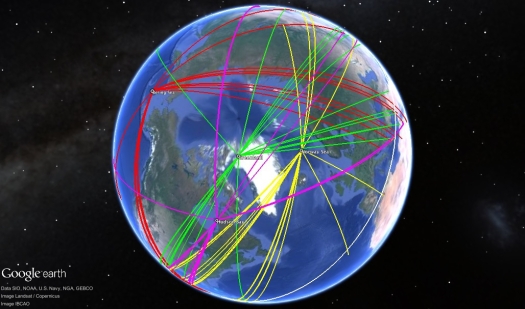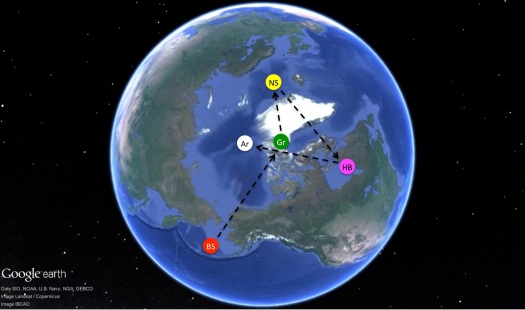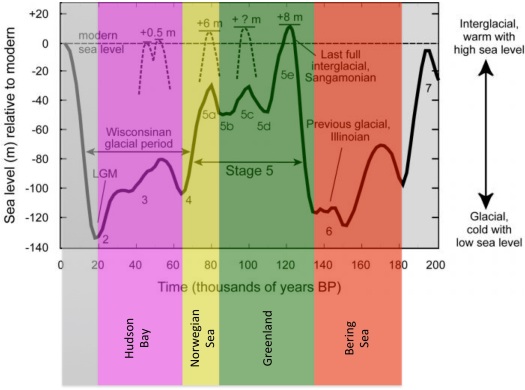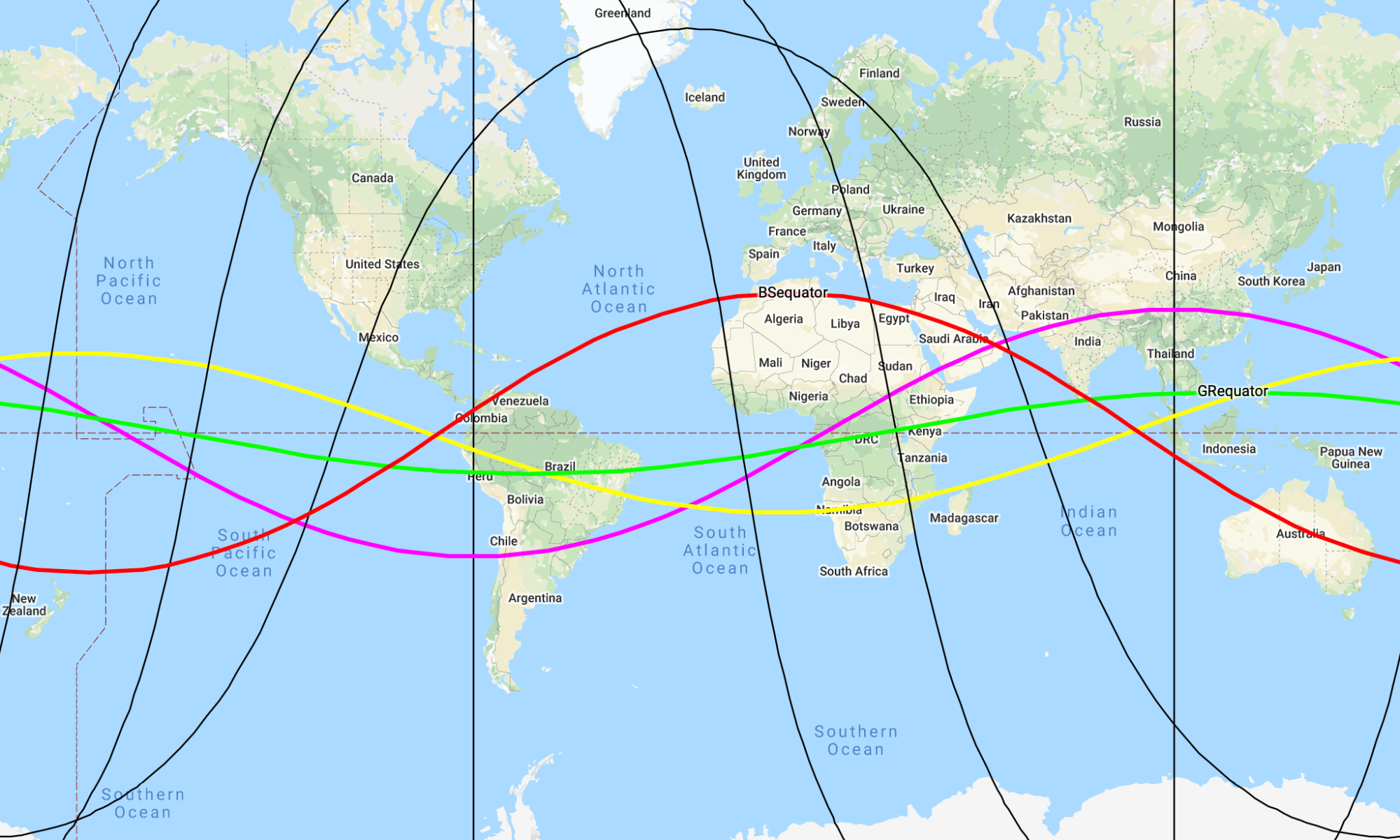In 1958 Charles Hapgood proposed that three displacements of the North Pole had occurred over the past 75,000 years. Last spring at a data fusion conference I presented a paper showing that over fifty ancient sites throughout the world appear to be aligned to previous locations of the pole. Since then more than one hundred additional sites have been found.
Although Hapgood’s theory is not generally accepted in the scientific community, that so many ancient sites seem to be aligned to previous poles raises the obvious question: if Hapgood’s theory is wrong why are so many sites aligned to them?
This article presents a revised sequence and timing of geographic pole shifts over the past 130,000 years based on new climate evidence.

Mollusks and Mammals
In examining the ‘extralimital anomaly’ of mollusk shells in the Americas, independent researcher Mark Gaffney has found new evidence supporting Hapgood’s theory of crustal displacement. Gaffney’s analysis posted last summer at Graham Hancock’s website shows that the locations of today’s faunal beds are displaced by more than a thousand miles from where they were at the end of the late Pleistocene. He determined from this displacement that before its present location in the Arctic, the previous location of the North Pole was on Baffin Island in northern Canada. This location is about 470 miles north of Hapgood’s Hudson Bay pole, and about 530 miles northeast of the location I had determined from site alignments.
Gaffney’s latest soon-to-be-published research reveals new climate evidence that supports Hapgood’s theory specifically in regard to the order and timing of pole shifts. My analysis of site alignment data using data fusion techniques revealed that Hapgood’s Greenland/Norway pole was really two separate poles, one in northern Greenland, and the other in the Norwegian Sea. Although I was able to resolve their locations, without additional data I was unable to determine which came first, i.e., did the pole shift from the Bering Sea, to the Norwegian Sea, to Greenland, and then to Hudson Bay, or was the sequence Bering Sea, Greenland, Norwegian Sea, and Hudson Bay?

By analyzing mammalian fossils in Late Pleistocene deposits in Britain Gaffney determined the sequence was likely the former with a pole shift from the Bering Sea to Greenland causing the climate in Europe to change from sub-tropical to temperate between 123,000 and 96,000 years ago, followed by a pole shift from Greenland to the Norwegian Sea that caused it to become much colder around 85,000 years ago. According to the fossil record, the climate then warmed up around 38,000 to 50,000 years ago, which is consistent with the pole moving to northern Canada and finally to its present location around 20,000 years ago.
Sea Level Change
Generally speaking, during glacial periods when there is more ice at the poles, sea levels are lower than during interglacial periods when there is less ice. The amount of ice depends on temperate, which in turn depends on how much solar radiation is absorbed at the surface or reflected by clouds and ice. Hapgood hypothesized pole shifts were caused by a build-up of ice in the polar regions that eventually create an imbalance large enough to cause the crust to slip over the mantle and shift the added mass toward the equator. When the mass of ice at the pole shifts to a lower latitude some of it melts leading to a rise in sea level. Then as ice begins to accumulate at the new pole, sea levels slowly decrease, and the cycle repeats. Using this basic pattern we can estimate the timing of pole shifts from sea-level changes.

Over 130,000 years ago at the time of the penultimate glacial maximum, sea levels were about 120 meters below current levels suggesting an ice cap comparable in size to the one at the last glacial maximum (LGM) at the end of the Wisconsinan glaciation. Hapgood estimated that during the Illinoian glaciation the North Pole was near the Yukon region in Canada, a location we have subsequently refined using site alignment data to a point in the Bering Sea north of the Aleutian Islands. When the pole shifted from the Bering Sea more than 2500 miles to northern Greenland much of this ice melted causing the sea level to rise 130 meters by around 120,000 years ago. As ice then began to accumulate at the new North Pole in northern Greenland sea levels began to decrease in stages. About 85,000 years ago the build-up of ice at the Greenland pole caused the North Pole to shift again but by a smaller distance, about 1250 miles, to the Norwegian Sea. The mass of ice in the polar region grew significantly over the next 20,000 years as Europe experienced a much colder climate. The continued imbalance in Earth’s moment of inertia created by a build-up of polar ice caused the pole to then shift to northern Canada about 65,000 years ago. Reaching its greatest extent at the time of the last glacial maximum, the pole moved to its present location in the Arctic about 20,000 years ago.
Dating Ancient Sites
Based on our revised sequence and timing of pole shifts we propose that places in Mexico such as Teotihuacan and Uxmal that are aligned to the Hudson Bay pole are 20,000 to 60,000 years old. Chichen Itza and sites that are aligned to the Norwegian Sea pole are 60,000 to 80,000 years old. Based on their alignment to the Greenland pole, we hypothesize that the original (pre-Aztec) settlement at Tenochtitlan in the heart of modern-day Mexico City and other sites in the Valley of Mexico are among the oldest archaeological sites in Mexico. Sites aligned in this direction could have been first established 80,000 to 130,000 years ago.
Sites in Peru’s Sacred Valley that are aligned to the Bering Sea pole including Machu Picchu and Ollantaytambo are more than 130,000 years old. If it is indeed artificial, by virtue of its alignment to the Bering Sea pole, the Bosnian Pyramid of the Sun could be the oldest structure in Europe.
Since they are aligned to the same pole, we hypothesize that the Acropolis in Athens and Tenochtitlan date to the same period. According to Plato’s dialog Critias:
“In the first place the Acropolis was not as now. For the fact is that a single night of excessive rain washed away the earth and laid bare the rock; at the same time there were earthquakes, and then occurred the extraordinary inundation, which was the third before the great destruction of Deucalion.”
If the Bering Sea to Greenland pole shift corresponded to the first destruction, the Greenland to Norway Sea to the second, the Norway Sea to Hudson Bay to the third, and the Hudson Bay to the present pole to the fourth, the original structures at the Acropolis were destroyed about 60,000 years ago.
The Greenland to Norwegian Sea pole shift moved Europe much closer to the pole than it is today. As a result of its colder subpolar climate, there are relatively few sites in western Europe aligned to the Norwegian Sea pole. After the pole shifted to Hudson Bay the climate in Europe warmed and many more sites were built there including the oracle of Apollo at Delphi and the Lion Gate at Mycenae, both of which were established before the last flood approximately 20,000 years ago.




Look at previous poll locations in reference to permafrost locations
LikeLike